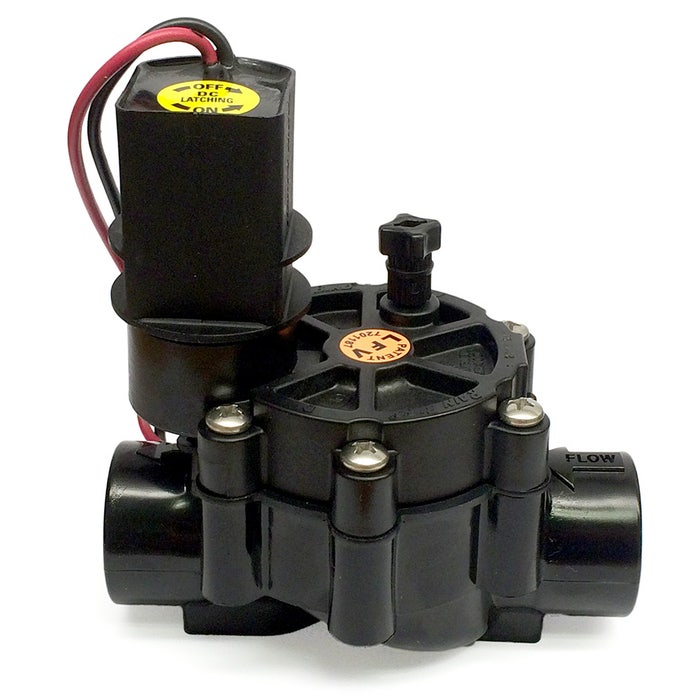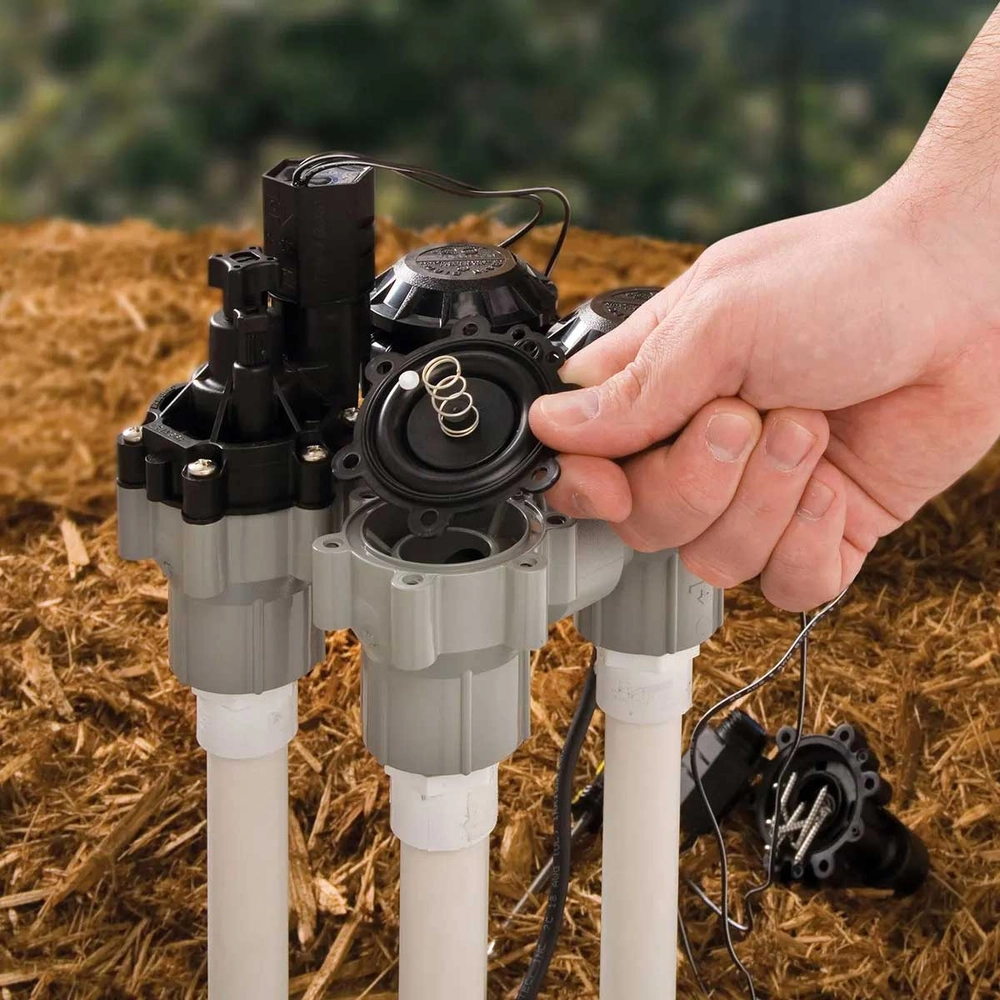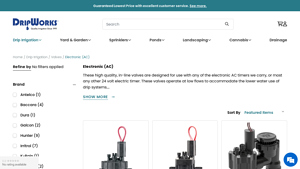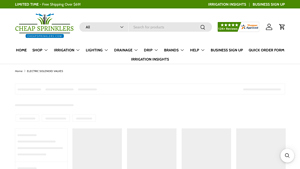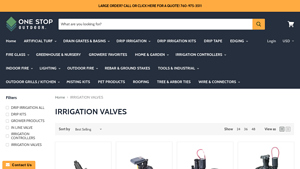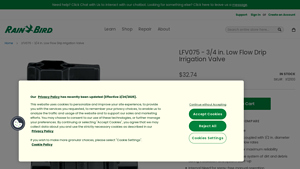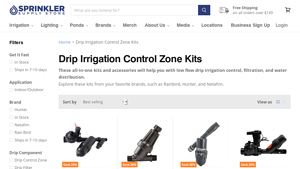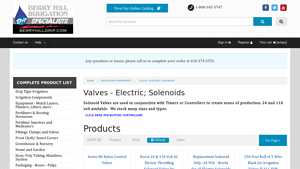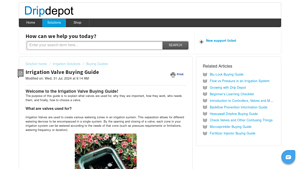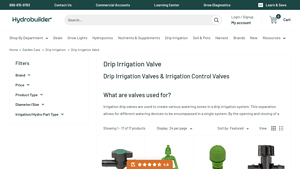Introduction: Navigating the Global Market for drip irrigation electric valve
In an era where efficient water management is paramount, sourcing the right drip irrigation electric valve can present a significant challenge for international B2B buyers. These valves are critical components of drip irrigation systems, ensuring precise water delivery while optimizing resource use in agriculture and landscaping. This guide is designed to empower buyers from diverse regions, including Africa, South America, the Middle East, and Europe, by providing in-depth insights into the various types of drip irrigation electric valves available, their specific applications, and the best practices for supplier vetting.
Throughout this comprehensive guide, we will explore the essential features of electric valves, including their compatibility with different irrigation systems and flow rates. We will delve into various applications, from large-scale agricultural operations to urban landscaping projects, and highlight the importance of selecting valves that meet specific environmental and operational needs. Furthermore, we will discuss cost factors, helping you understand the investment required for high-quality solutions that enhance water efficiency.
By addressing the complexities of sourcing drip irrigation electric valves, this guide equips B2B buyers with actionable insights, enabling informed purchasing decisions that align with sustainability goals and operational efficiency. Whether you are in Saudi Arabia looking to optimize desert agriculture or in Nigeria seeking to improve crop yields, this resource will serve as your go-to reference for making strategic, informed choices in the global market.
Understanding drip irrigation electric valve Types and Variations
| Type Name | Key Distinguishing Features | Primary B2B Applications | Brief Pros & Cons for Buyers |
|---|---|---|---|
| Electronic AC Valves | Operate at low flows, compatible with 24V timers, high-quality construction | Greenhouses, nurseries, and agricultural fields | Pros: Reliable operation; Cons: Limited to AC power supply. |
| DC Solenoid Valves | Magnetic latching technology, low power consumption, available in various sizes | Residential and commercial drip systems | Pros: Energy-efficient; Cons: May require specific controllers. |
| Low Flow Drip Irrigation Valves | Designed for low flow rates, unique diaphragm for particle passage | Specialty crops, orchards, and vineyards | Pros: Prevents weeping; Cons: Higher upfront costs. |
| Anti-Siphon Valves | Prevents backflow, integrated with solenoid for automatic operation | Systems in areas with potential contamination | Pros: Protects water quality; Cons: Can be more complex to install. |
| Control Zone Kits | All-in-one solutions with valves, filters, and controllers | Large-scale agricultural operations | Pros: Simplifies installation; Cons: May include unnecessary components. |
What Are the Key Characteristics of Electronic AC Valves in Drip Irrigation?
Electronic AC valves are specifically designed for low-flow applications and are compatible with various 24-volt timers. These valves are ideal for use in greenhouses and nurseries, where precise water control is essential. When considering these valves, B2B buyers should assess their compatibility with existing systems and the availability of AC power sources, as these valves are not suitable for DC applications.
How Do DC Solenoid Valves Enhance Drip Irrigation Systems?
DC solenoid valves utilize magnetic latching technology, making them highly energy-efficient. They are versatile and come in various sizes, suitable for both residential and commercial drip irrigation systems. Buyers should evaluate their specific power requirements and ensure compatibility with existing controllers. The low power consumption makes them an attractive option for businesses looking to reduce operational costs.
Why Choose Low Flow Drip Irrigation Valves for Specialty Crops?
Low flow drip irrigation valves are engineered to handle the unique demands of low flow rates, featuring a patented diaphragm design that allows particles to pass through without causing blockages. These valves are particularly beneficial for specialty crops, orchards, and vineyards, where water precision is critical. B2B purchasers should consider the initial investment against long-term operational efficiency and maintenance costs.
What Advantages Do Anti-Siphon Valves Offer in Drip Irrigation?
Anti-siphon valves are essential for preventing backflow, which can contaminate water supplies. These valves are typically integrated with solenoids for automatic operation, making them ideal for installations in areas where contamination risk is high. Buyers should weigh the complexity of installation against the significant benefit of maintaining water quality in their irrigation systems.
How Do Control Zone Kits Streamline Drip Irrigation Setup?
Control zone kits provide a comprehensive solution by combining valves, filters, and controllers into a single package. This all-in-one approach simplifies installation for large-scale agricultural operations, making it easier to manage multiple zones. Buyers should assess the components included in the kit to ensure they meet their specific irrigation needs and avoid purchasing unnecessary extras.
Key Industrial Applications of drip irrigation electric valve
| Industry/Sector | Specific Application of drip irrigation electric valve | Value/Benefit for the Business | Key Sourcing Considerations for this Application |
|---|---|---|---|
| Agriculture | Automated irrigation systems for crop production | Enhances water efficiency, reduces labor costs | Compatibility with existing irrigation systems, voltage ratings |
| Horticulture | Precision watering for greenhouses and nurseries | Promotes optimal plant growth, minimizes water wastage | Durability under varied environmental conditions, flow rates |
| Landscaping | Smart irrigation for commercial landscapes and parks | Improves aesthetic appeal, lowers water consumption | Integration with smart controllers, ease of maintenance |
| Municipal Water Supply | Drip irrigation in urban agriculture initiatives | Supports sustainable urban development, improves food security | Compliance with local regulations, scalability options |
| Sports Turf Management | Irrigation systems for sports fields | Ensures optimal playing conditions, reduces maintenance costs | Resistance to wear and tear, quick response times |
How is Drip Irrigation Electric Valve Used in Agriculture?
In the agriculture sector, drip irrigation electric valves are integral to automated irrigation systems that optimize water usage for crop production. These valves enable precise control over water flow, allowing farmers to manage irrigation schedules based on crop needs, soil moisture levels, and climatic conditions. This results in improved crop yields and significant reductions in water waste, making it essential for regions facing water scarcity, such as parts of Africa and the Middle East. Buyers should consider compatibility with existing irrigation infrastructure and the voltage requirements of the valves to ensure seamless integration.
What Role Do Drip Irrigation Electric Valves Play in Horticulture?
For horticulture, particularly in greenhouses and nurseries, drip irrigation electric valves facilitate precision watering tailored to the specific requirements of various plant species. These valves help maintain optimal moisture levels, which is crucial for promoting healthy growth and minimizing the risk of disease. The ability to automate watering schedules further reduces labor costs and enhances operational efficiency. Buyers should focus on the durability of the valves in humid environments and their ability to handle low flow rates, as these factors directly impact performance.
How Can Landscaping Benefit from Drip Irrigation Electric Valves?
In landscaping, drip irrigation electric valves are employed in smart irrigation systems that cater to commercial landscapes and parks. By controlling water distribution precisely, these systems not only enhance the visual appeal of green spaces but also contribute to significant water savings. The integration of these valves with smart controllers allows for real-time adjustments based on weather conditions, ensuring that landscapes remain vibrant without unnecessary water usage. For international buyers, ease of maintenance and the ability to integrate with existing systems are critical factors to consider.
What is the Importance of Drip Irrigation Electric Valves in Municipal Water Supply?
Drip irrigation electric valves are increasingly being utilized in urban agriculture initiatives within municipal water supply systems. These applications support sustainable urban development by enabling efficient water use in community gardens and urban farms, thereby improving local food security. Municipalities should ensure that the valves comply with local regulations and can scale to meet varying demands. Buyers should also assess the valves’ performance in different pressure conditions to guarantee reliability in diverse urban settings.
How Do Drip Irrigation Electric Valves Enhance Sports Turf Management?
In sports turf management, drip irrigation electric valves are essential for maintaining optimal conditions on sports fields. These valves allow for precise watering schedules that ensure the turf remains healthy and playable, reducing maintenance costs associated with over-watering or drought stress. The ability to respond quickly to changing weather conditions is vital, making the selection of valves with robust performance characteristics crucial for buyers in this sector. Additionally, durability against wear and tear is a key consideration for maintaining high-quality playing surfaces.
3 Common User Pain Points for ‘drip irrigation electric valve’ & Their Solutions
Scenario 1: Inconsistent Water Flow and Pressure Issues
The Problem: B2B buyers often encounter inconsistent water flow and pressure in their drip irrigation systems, particularly in regions with varying water supply conditions. This inconsistency can lead to uneven watering of crops, resulting in reduced yield and wasted resources. Electric valves may not activate or deactivate as expected due to fluctuations in voltage or pressure, causing frustration among agricultural managers who depend on precise irrigation for optimal crop growth.
The Solution: To tackle these issues, it is crucial to invest in high-quality electric valves specifically designed for low-flow applications, such as those with a unique diaphragm design that accommodates variable flow rates. Buyers should seek valves with features like double-filtered pilot flow designs to enhance reliability and performance. Additionally, employing a pressure regulator can stabilize the water pressure feeding into the system. It is recommended to work closely with suppliers who can provide comprehensive specifications and testing reports, ensuring that the valves chosen are compatible with local conditions and provide consistent performance.
Scenario 2: Frequent Maintenance and Repair Needs
The Problem: Another common challenge faced by buyers is the frequent maintenance and repair needs of drip irrigation electric valves. In regions where soil quality is variable and debris is common, valves can clog or suffer from mechanical failures, leading to increased operational downtime and maintenance costs. This situation is particularly problematic for large-scale agricultural operations that rely on uninterrupted irrigation schedules.
The Solution: To mitigate maintenance issues, buyers should focus on sourcing electric valves equipped with robust filtration systems and self-cleaning features. Opt for models that allow for easy access to internal components for cleaning and replacement. Additionally, regular system audits and preventive maintenance schedules can help identify potential issues before they escalate. Partnering with suppliers that offer extended warranties and technical support can also provide peace of mind, ensuring that any malfunction can be quickly addressed without significant downtime.
Scenario 3: Complex Installation and Integration Challenges
The Problem: B2B buyers often struggle with the complex installation and integration of drip irrigation electric valves into existing systems. This challenge is exacerbated in regions where technical expertise is limited, leading to improper installations that compromise system efficiency. Without adequate training and support, even high-quality valves can underperform due to incorrect setup, leading to wasted resources and suboptimal crop performance.
The Solution: To simplify installation, buyers should consider purchasing integrated drip irrigation control zone kits that include electric valves, filters, and necessary fittings. These kits typically come with detailed installation instructions and are designed for seamless integration into existing systems. It is also beneficial to invest in training sessions for local technicians or work with suppliers who provide on-site training to ensure proper installation and integration. Engaging with local agricultural extension services can further enhance understanding of best practices, ensuring that the systems operate efficiently from the outset.
Strategic Material Selection Guide for drip irrigation electric valve
What Are the Key Materials Used in Drip Irrigation Electric Valves?
When selecting materials for drip irrigation electric valves, it is essential to consider their properties, advantages, disadvantages, and suitability for specific applications. Below are analyses of four common materials used in these valves: PVC, brass, stainless steel, and plastic composites.
How Does PVC Perform in Drip Irrigation Electric Valves?
Key Properties: PVC (Polyvinyl Chloride) is lightweight, resistant to corrosion, and has a temperature rating of up to 140°F (60°C). It is generally suitable for low-pressure applications, typically up to 150 psi.
Pros & Cons: PVC is cost-effective and easy to manufacture, making it a popular choice for budget-conscious buyers. However, it can become brittle over time, especially when exposed to UV rays, and may not withstand high temperatures or pressures.
Impact on Application: PVC is compatible with most water sources but may not be suitable for applications involving aggressive chemicals or extreme temperatures.
Considerations for International Buyers: PVC valves should comply with local standards such as ASTM in the U.S. or EN standards in Europe. Buyers in regions like Africa and the Middle East should consider the potential for UV exposure and select UV-stabilized PVC to ensure longevity.
What Are the Advantages of Brass in Drip Irrigation Electric Valves?
Key Properties: Brass is known for its high strength and excellent corrosion resistance, withstanding temperatures up to 250°F (121°C) and pressures exceeding 300 psi.
Pros & Cons: Brass valves are durable and provide a reliable seal, making them suitable for high-pressure applications. However, they are more expensive than PVC and can be susceptible to dezincification in certain water conditions.
Impact on Application: Brass is compatible with various media, including potable water, making it ideal for agricultural applications where water quality is a concern.
Considerations for International Buyers: Compliance with standards such as JIS in Japan or DIN in Europe is crucial. Buyers should also consider the local availability of brass valves, as they may be subject to import tariffs in certain regions.
Why Choose Stainless Steel for Drip Irrigation Electric Valves?
Key Properties: Stainless steel offers superior corrosion resistance, high strength, and can operate in extreme temperatures and pressures, often exceeding 300°F (149°C) and 500 psi.
Pros & Cons: The durability and long lifespan of stainless steel make it ideal for harsh environments. However, it is significantly more expensive than PVC and brass, and its manufacturing process can be complex.
Impact on Application: Stainless steel valves are suitable for applications involving aggressive chemicals or saline environments, making them ideal for coastal regions or areas with high mineral content in water.
Considerations for International Buyers: Buyers should ensure compliance with international standards such as ASTM and ISO. In regions with high humidity or saline conditions, stainless steel valves are often preferred despite the higher initial investment.
How Do Plastic Composites Compare in Drip Irrigation Electric Valves?
Key Properties: Plastic composites combine various materials to enhance performance, offering good temperature and pressure ratings, typically up to 200°F (93°C) and 150 psi.
Pros & Cons: These materials are lightweight, resistant to corrosion, and can be tailored for specific applications. However, they may not have the same durability as metal options and can be more expensive than traditional plastics.
Impact on Application: Plastic composites are versatile and can be designed for specific media compatibility, making them suitable for various agricultural applications.
Considerations for International Buyers: Buyers should look for certifications that ensure the composite materials meet local and international standards, particularly in regions with stringent agricultural regulations.
Summary of Material Selection for Drip Irrigation Electric Valves
| Material | Typical Use Case for drip irrigation electric valve | Key Advantage | Key Disadvantage/Limitation | Relative Cost (Low/Med/High) |
|---|---|---|---|---|
| PVC | Low-pressure, general irrigation | Cost-effective and lightweight | Brittle over time, UV exposure | Low |
| Brass | High-pressure applications, potable water | Durable and reliable seal | Higher cost, dezincification risk | Med |
| Stainless Steel | Harsh environments, saline or chemical exposure | Superior corrosion resistance | High cost, complex manufacturing | High |
| Plastic Composites | Versatile applications, tailored performance | Lightweight and customizable | Less durable than metals | Med |
This material selection guide provides B2B buyers with essential insights to make informed decisions when sourcing drip irrigation electric valves, considering both performance and regional compliance.
In-depth Look: Manufacturing Processes and Quality Assurance for drip irrigation electric valve
What Are the Key Stages in the Manufacturing Process of Drip Irrigation Electric Valves?
The manufacturing process for drip irrigation electric valves encompasses several critical stages, each designed to ensure the final product meets stringent performance and quality standards. Here’s a breakdown of the main stages involved:
Material Preparation: What Raw Materials Are Used?
The manufacturing process begins with material selection. Commonly used materials include high-density polyethylene (HDPE), brass, and stainless steel, which are chosen for their durability, resistance to corrosion, and ability to withstand varying pressure levels. The materials undergo rigorous quality checks to ensure they meet international standards before being sent for further processing.
Forming: How Are Valves Shaped?
In the forming stage, the raw materials are processed using techniques such as injection molding or machining. Injection molding is frequently employed for plastic components, allowing for precise shaping and reduced waste. For metal parts, machining processes like CNC (Computer Numerical Control) milling and turning are utilized to achieve tight tolerances and complex geometries. These methods ensure that each valve can handle the low flow rates typical of drip irrigation systems while maintaining functionality.
Assembly: What Techniques Are Used to Put Valves Together?
Once individual components are formed, they move to the assembly stage. This typically involves automated assembly lines where parts are fitted together using techniques such as ultrasonic welding, adhesive bonding, or mechanical fastening. Automation enhances consistency and reduces assembly errors, ensuring each valve functions correctly. Quality control checks are integrated into the assembly process to catch any defects early.
Finishing: How Are Valves Prepared for Market?
The finishing stage includes processes such as surface treatment, painting, or coating to enhance durability and aesthetics. Common treatments include anti-corrosive coatings or UV protection, which are particularly important for valves intended for outdoor use in regions with high sun exposure, such as Africa and the Middle East. This stage also involves final inspections to ensure that all valves meet the specified design and quality criteria.
What Quality Assurance Measures Are Essential in Manufacturing Drip Irrigation Electric Valves?
Quality assurance is crucial in the manufacturing of drip irrigation electric valves, as it directly impacts performance, reliability, and customer satisfaction. Here are some key aspects of quality assurance:
What International Standards Apply to Drip Irrigation Electric Valves?
Manufacturers typically adhere to international quality standards such as ISO 9001, which outlines requirements for a quality management system. Additionally, industry-specific certifications like CE marking (for compliance with European health, safety, and environmental protection standards) and API (American Petroleum Institute) standards may also be applicable, particularly for valves used in more demanding irrigation applications.
What Are the Key Quality Control Checkpoints?
Quality control (QC) checkpoints are strategically placed throughout the manufacturing process to ensure product integrity. These checkpoints include:
- Incoming Quality Control (IQC): This involves inspecting raw materials upon arrival to ensure they meet predefined specifications.
- In-Process Quality Control (IPQC): During the manufacturing stages, ongoing inspections are conducted to identify defects early. This might include monitoring temperature, pressure, and flow rates during valve formation.
- Final Quality Control (FQC): Before products are shipped, final inspections are performed to assess functionality, durability, and compliance with standards.
What Common Testing Methods Are Used to Ensure Quality?
Testing methods include hydraulic testing, where valves are subjected to pressure to ensure they can withstand operational conditions without leaking. Additionally, performance tests, such as flow rate assessments and response times, help verify that the valves function as intended under various conditions. Electromagnetic compatibility (EMC) testing is also important for electric components to ensure they do not interfere with other electronic devices.
How Can B2B Buyers Verify Supplier Quality Control Practices?
B2B buyers, especially those operating in international markets, should take proactive steps to verify the quality control practices of potential suppliers. Here are some strategies:
What Role Do Audits and Reports Play in Supplier Verification?
Conducting on-site audits of suppliers can provide firsthand insights into their manufacturing processes and quality assurance practices. During these audits, buyers can evaluate adherence to international standards and the effectiveness of their quality control systems. Suppliers should be willing to provide detailed reports on their quality management systems, including compliance certifications and test results.
How Can Third-Party Inspections Enhance Confidence?
Engaging third-party inspection services can add an extra layer of assurance. These organizations specialize in assessing manufacturing practices and can verify that suppliers comply with relevant standards. This is particularly important for buyers in regions like Africa and South America, where local regulations may differ significantly from those in Europe or the Middle East.
What Nuances Should International Buyers Consider Regarding Quality Control?
International buyers must be aware of various nuances when dealing with quality control. For instance, regulations may vary significantly between regions. Buyers from Europe, for example, may prioritize CE compliance, while those in the Middle East might be more concerned with local certifications. Understanding these differences is essential for successful procurement.
Additionally, language barriers and cultural differences can impact communication regarding quality expectations. Establishing clear communication channels and documentation processes will help mitigate misunderstandings and ensure that both parties are aligned on quality standards.
In conclusion, a thorough understanding of the manufacturing processes and quality assurance measures for drip irrigation electric valves is vital for international B2B buyers. By focusing on material selection, production techniques, and rigorous quality control practices, buyers can ensure they source reliable products that meet their operational needs.
Practical Sourcing Guide: A Step-by-Step Checklist for ‘drip irrigation electric valve’
The following guide provides a structured approach for B2B buyers looking to procure drip irrigation electric valves. This checklist will help ensure you make informed decisions that align with your agricultural needs and operational capabilities.
Step 1: Define Your Technical Specifications
Understanding the technical requirements for the electric valves you need is crucial. Consider factors such as flow rates, pressure ratings, and voltage compatibility. This step ensures that the valves will function optimally within your existing irrigation system.
– Flow Rate: Ensure the valve can handle the specific flow rates of your drip irrigation setup.
– Pressure Ratings: Verify that the valve can operate effectively at the pressures typical for your region.
Step 2: Research Industry Standards
Familiarize yourself with the industry standards applicable to drip irrigation electric valves. Compliance with standards such as ISO, ASTM, or local agricultural regulations can impact the quality and reliability of the valves.
– Quality Assurance: Look for valves that meet these standards to ensure durability and performance.
– Environmental Considerations: Check if the products adhere to any environmental regulations relevant to your region.
Step 3: Evaluate Potential Suppliers
Before committing to a purchase, it is essential to thoroughly vet potential suppliers. Request company profiles, case studies, and references from buyers in similar industries or regions.
– Supplier Reputation: Assess the supplier’s track record in delivering quality products and customer service.
– Technical Support: Inquire about the availability of technical assistance and after-sales support.
Step 4: Request Samples or Prototypes
Whenever possible, request samples or prototypes of the electric valves you are considering. This hands-on evaluation allows you to test the product’s quality and suitability for your specific application.
– Testing: Conduct tests under actual operating conditions to assess performance.
– Fit and Compatibility: Ensure that the sample fits seamlessly into your current irrigation infrastructure.
Step 5: Compare Pricing and Terms
Once you have shortlisted potential suppliers, compare their pricing structures and payment terms. Look beyond the upfront costs to understand the total cost of ownership, including installation and maintenance.
– Bulk Discounts: Inquire about potential discounts for bulk purchases.
– Warranty and Return Policy: Check the warranty period and the return policy in case of defects or unsatisfactory performance.
Step 6: Verify Certifications and Compliance
Ensure that the valves comply with necessary certifications and regulations. This step is crucial for ensuring product quality and compliance with local agricultural guidelines.
– Electrical Safety Certifications: Look for certifications like CE or UL that indicate compliance with electrical safety standards.
– Environmental Certifications: Ensure the product is compliant with environmental regulations relevant to your region.
Step 7: Finalize Logistics and Delivery
After selecting a supplier, confirm logistics and delivery timelines. Clear communication regarding shipping methods, expected delivery dates, and handling procedures will help avoid delays.
– Shipping Costs: Factor in shipping costs when finalizing your budget.
– Customs and Duties: Be aware of any customs regulations or duties that may apply when importing the valves to your region.
Following this checklist will help you navigate the procurement process effectively, ensuring that you select the right drip irrigation electric valves for your agricultural needs.
Comprehensive Cost and Pricing Analysis for drip irrigation electric valve Sourcing
What Are the Key Cost Components in Sourcing Drip Irrigation Electric Valves?
When analyzing the cost structure for drip irrigation electric valves, several components must be taken into account. Materials represent a significant portion of the overall cost. High-quality plastics and metals used in valve construction ensure durability and efficiency but can elevate costs.
Labor costs vary depending on the manufacturing location. Regions with higher wage standards, such as parts of Europe, will naturally incur higher labor costs compared to manufacturing bases in Africa or South America. Manufacturing overhead includes utilities, facility maintenance, and administrative expenses, contributing to the price per unit.
Tooling costs, which involve the machinery and equipment required to produce the valves, are also crucial. The initial investment can be significant, particularly for custom designs. Additionally, quality control (QC) processes to ensure that each valve meets performance specifications add to the overall cost. Finally, logistics, encompassing shipping and handling, is a vital cost factor, especially for international buyers who must consider tariffs and import duties.
How Do Price Influencers Affect Drip Irrigation Electric Valve Costs?
Several factors can influence the pricing of drip irrigation electric valves. Volume and minimum order quantities (MOQ) play a critical role; larger orders typically yield discounts. Customization requirements, including specific valve sizes or functionalities, may lead to increased costs due to the need for specialized tooling and additional manufacturing processes.
The choice of materials impacts pricing as well. For instance, valves made from corrosion-resistant materials or those with advanced features like anti-siphon capabilities generally command a premium. Additionally, the quality and certifications of the product can affect pricing. Valves with industry certifications may be priced higher but offer better reliability and longevity.
Supplier factors such as reputation, reliability, and service quality are also essential considerations. Established suppliers may charge higher prices due to their brand value but often provide better service and product guarantees. Finally, Incoterms determine the responsibilities of buyers and sellers regarding shipping, which can influence overall costs.
What Are the Best Buyer Tips for Negotiating Prices on Electric Valves?
International B2B buyers must adopt strategic approaches when negotiating prices for drip irrigation electric valves. Understanding the Total Cost of Ownership (TCO) is vital. This includes not just the purchase price but also installation, maintenance, and operational costs over the product’s lifespan. By evaluating TCO, buyers can make informed decisions that go beyond the initial price tag.
When negotiating, leverage volume discounts by consolidating orders or collaborating with other buyers to increase purchasing power. Always inquire about potential customization options that may provide cost-effective alternatives without sacrificing quality.
Buyers should also familiarize themselves with pricing nuances specific to their regions. For example, understanding local market conditions in Africa, South America, or the Middle East can provide insight into competitive pricing and supplier capabilities.
Finally, transparency in logistics and Incoterms is crucial for international transactions. Ensure clarity on shipping costs, potential tariffs, and delivery timelines, as these can significantly impact overall pricing.
Conclusion: What Should International Buyers Consider When Sourcing Electric Valves?
While indicative prices for drip irrigation electric valves can range widely based on specifications and sourcing locations, understanding the underlying cost components and pricing influencers is essential for making informed purchasing decisions. Buyers should focus on comprehensive evaluations of suppliers, material quality, and long-term costs to ensure that they secure not only the best price but also the best value for their investment.
Alternatives Analysis: Comparing drip irrigation electric valve With Other Solutions
Exploring Alternative Solutions to Drip Irrigation Electric Valves
In the realm of agricultural irrigation, selecting the appropriate system is crucial for optimizing water use and maximizing crop yield. While drip irrigation electric valves are a popular choice for controlled water distribution, various alternative solutions also exist, each with unique advantages and drawbacks. This analysis provides a comparative overview of drip irrigation electric valves against two viable alternatives: manual valves and solenoid valves.
Comparison Table
| Comparison Aspect | Drip Irrigation Electric Valve | Manual Valve | Solenoid Valve |
|---|---|---|---|
| Performance | High precision in flow control; low flow capability (0.2-8 GPM) | Moderate control; dependent on manual operation | Effective at various flow rates; quick response time |
| Cost | Moderate initial investment; long-term savings on water usage | Low initial cost; potential for higher labor costs | Variable costs; typically higher than manual valves |
| Ease of Implementation | Requires electrical setup; user-friendly with timers | Simple installation; no electrical work needed | Requires electrical setup; can be complex |
| Maintenance | Low maintenance; durable with proper care | Higher maintenance due to wear and tear | Moderate maintenance; solenoid replacements may be needed |
| Best Use Case | Ideal for precision agriculture and automated systems | Suitable for small farms or manual operations | Best for larger systems needing rapid response |
In-Depth Analysis of Alternatives
What Are the Advantages and Disadvantages of Manual Valves?
Manual valves are a traditional option for irrigation systems, providing straightforward operation without the need for electrical components. They are generally less expensive to purchase and install. However, their reliance on manual intervention means that they can lead to inconsistent water distribution and labor-intensive management. This makes them less suitable for large-scale operations or regions where labor costs are high.
How Do Solenoid Valves Compare to Drip Irrigation Electric Valves?
Solenoid valves utilize electromagnetic coils to control water flow, offering quick and responsive irrigation management. They can handle a range of flow rates and are suitable for both drip and sprinkler systems. However, solenoid valves typically come with a higher initial cost and may require more complex installation compared to manual valves. Additionally, they necessitate electrical connections and regular maintenance to ensure functionality, especially in environments with high debris levels.
How to Choose the Right Irrigation Solution for Your Business Needs
For B2B buyers evaluating irrigation systems, the choice between drip irrigation electric valves, manual valves, and solenoid valves will depend on specific operational requirements. If precision and automation are key priorities, electric valves are advantageous due to their ability to manage low flow rates and integrate with advanced irrigation controllers. Conversely, for smaller operations or areas with low labor costs, manual valves may offer an economical solution. Solenoid valves serve as a middle ground, providing flexibility for varying irrigation needs but requiring more investment in setup and maintenance.
Ultimately, understanding the unique characteristics of each alternative allows buyers to make informed decisions that align with their agricultural goals and operational capabilities.
Essential Technical Properties and Trade Terminology for drip irrigation electric valve
What Are the Key Technical Properties of Drip Irrigation Electric Valves?
When considering drip irrigation electric valves, understanding their technical specifications is crucial for making informed purchasing decisions. Here are some essential properties to consider:
Material Grade
The material used in the construction of electric valves significantly impacts durability and performance. Common materials include PVC, brass, and stainless steel. Each material has its advantages; for example, brass valves offer high resistance to corrosion, making them suitable for various water qualities, while PVC is lighter and more cost-effective. Selecting the right material ensures longevity and reliability, especially in diverse environmental conditions found in regions like Africa and the Middle East.Flow Rate
Flow rate is a critical parameter that defines how much water the valve can handle, typically measured in gallons per minute (GPM) or liters per minute (LPM). For drip irrigation systems, valves are designed for low flow rates, usually ranging from 0.2 to 8 GPM. Understanding the flow rate is vital for ensuring that the irrigation system meets the specific watering needs of different crops, helping to optimize water usage and minimize waste.Operating Pressure
The operating pressure of a valve, measured in psi (pounds per square inch) or bars, indicates the pressure range within which the valve can function effectively. Most electric valves operate between 15 to 150 psi. Ensuring compatibility with the irrigation system’s pressure requirements is essential for preventing leaks and maintaining efficient operation, especially in high-pressure environments.Electrical Specifications
Electric valves often operate on specific voltage standards, such as 24 VAC or DC. It’s crucial to match the valve’s electrical requirements with the existing irrigation control system to avoid malfunction or damage. Additionally, understanding inrush and holding currents is important for selecting compatible power sources and controllers.Diaphragm Type
The diaphragm type influences the valve’s response to pressure changes and its ability to handle low flow rates. Designs such as double-knife diaphragms are particularly effective in preventing weeping at low flows, which is critical for maintaining system efficiency. This feature is particularly important in regions with limited water resources.
What Are Common Trade Terms Related to Drip Irrigation Electric Valves?
Familiarity with industry jargon can help streamline communication and negotiations with suppliers. Here are several key terms:
OEM (Original Equipment Manufacturer)
This term refers to companies that produce parts or equipment that may be marketed by another manufacturer. For buyers, understanding OEM products can help ensure that they are sourcing high-quality components that are compatible with their systems.MOQ (Minimum Order Quantity)
MOQ is the smallest quantity of a product that a supplier is willing to sell. Knowing the MOQ is essential for planning purchases and managing inventory, especially for businesses looking to optimize costs while ensuring they have sufficient supplies.RFQ (Request for Quotation)
An RFQ is a document that buyers send to suppliers requesting pricing for specific products or services. Issuing an RFQ can facilitate competitive pricing and allow buyers to make more informed decisions based on cost and value.Incoterms (International Commercial Terms)
These are standardized trade terms that define the responsibilities of buyers and sellers in international transactions. Understanding Incoterms is critical for managing logistics, risk, and costs associated with the shipping of electric valves across borders.Flow Control
Flow control refers to the ability to regulate the amount of water passing through the valve. This feature is essential for optimizing irrigation efficiency and ensuring that crops receive the appropriate amount of water.Pressure Regulation
Pressure regulation involves controlling the pressure within the irrigation system to prevent damage to components and ensure consistent water delivery. This is particularly important in areas with fluctuating water supply pressures.
Understanding these technical properties and trade terms will empower B2B buyers to make informed decisions when sourcing drip irrigation electric valves, ensuring that they choose products that meet their operational needs and comply with regional requirements.
Navigating Market Dynamics and Sourcing Trends in the drip irrigation electric valve Sector
What are the Global Drivers and Key Trends in the Drip Irrigation Electric Valve Market?
The global drip irrigation electric valve market is experiencing significant growth, driven by various factors, including the increasing need for water-efficient agricultural practices, rising labor costs, and a surge in food production demands. Countries in Africa, South America, the Middle East, and Europe are particularly focused on optimizing water resources due to variable climate conditions and limited freshwater supplies. This has led to a growing adoption of smart irrigation technologies, which integrate electric valves with automated systems for real-time monitoring and control, enhancing operational efficiency.
Emerging trends in B2B sourcing include the shift towards integrated irrigation solutions that incorporate electric valves as part of broader system kits. These kits often feature components like filters and controllers, allowing for streamlined purchasing and implementation. Additionally, the rise of IoT-enabled devices is transforming traditional irrigation practices. B2B buyers are increasingly seeking suppliers that offer connected solutions, enabling remote management and data analytics capabilities.
Moreover, sustainability is becoming a focal point for international buyers. Manufacturers are responding to this demand by investing in innovative technologies that reduce waste and enhance the durability of electric valves. As a result, buyers are prioritizing suppliers that demonstrate a commitment to quality and sustainability, aligning with global trends towards responsible sourcing and environmental stewardship.
How Does Sustainability Influence Sourcing Decisions in the Drip Irrigation Sector?
Sustainability is a critical consideration for B2B buyers in the drip irrigation electric valve sector. The environmental impact of irrigation systems is significant, as inefficient systems can lead to water wastage and soil degradation. Buyers are increasingly aware of the need for products that not only perform well but also contribute to sustainable agricultural practices. This has led to a demand for electric valves made from environmentally friendly materials and those that feature energy-efficient designs.
Ethical sourcing is equally important. B2B buyers are looking for suppliers who adhere to strict labor and environmental standards throughout their supply chains. Certifications such as ISO 14001 for environmental management and Fair Trade certifications are becoming key indicators of a supplier’s commitment to ethical practices. Additionally, products that incorporate recycled materials or are designed for disassembly and recycling at the end of their lifecycle are gaining traction.
By prioritizing sustainability and ethical sourcing, international buyers can enhance their brand reputation, meet regulatory requirements, and cater to a growing consumer preference for environmentally responsible products. This trend not only aligns with global efforts to combat climate change but also supports the long-term viability of agricultural practices in water-scarce regions.
What is the Historical Context of Drip Irrigation Electric Valves in B2B Markets?
The evolution of drip irrigation systems can be traced back to the mid-20th century when the need for efficient water use in agriculture became paramount. Initially, irrigation methods were labor-intensive and often wasteful. The introduction of electric valves transformed these systems, allowing for precise control over water distribution. Early electric valves were primarily mechanical, but advancements in technology have led to the development of sophisticated electronic and smart valves that enhance efficiency and reduce operational costs.
As the agricultural sector grew increasingly aware of the importance of water conservation, the demand for reliable and efficient drip irrigation systems surged. This led to innovation in valve design, focusing on materials that withstand harsh conditions and provide consistent performance at low flow rates. Today, electric valves are integral to modern irrigation systems, reflecting the broader trend towards automation and precision agriculture. B2B buyers now benefit from a wealth of options that cater to diverse agricultural needs, supported by a robust supply chain that emphasizes quality and sustainability.
Frequently Asked Questions (FAQs) for B2B Buyers of drip irrigation electric valve
How do I select the right electric valve for my drip irrigation system?
Choosing the right electric valve involves assessing several factors, including flow rate, pressure requirements, and compatibility with your irrigation system. For drip irrigation, opt for valves specifically designed for low flow rates, such as those rated between 0.2 to 8 GPM. Ensure the valve is compatible with your timer or control system, typically using a 24 VAC power supply. Additionally, consider the valve’s material for durability and resistance to environmental factors, especially in regions with extreme climates.What are the key features to look for in drip irrigation electric valves?
When sourcing drip irrigation electric valves, prioritize features such as low flow operation, reliability, and ease of maintenance. Look for valves with a double-filtered pilot flow design to prevent clogging and ensure smooth operation. External and internal bleed options can also be beneficial for manual flushing and system startup. Additionally, consider valves with built-in pressure regulation to maintain consistent water delivery and prevent system damage.What is the typical lead time for ordering electric valves for drip irrigation?
Lead times can vary significantly based on the supplier, order size, and customization requirements. Generally, standard orders may take anywhere from 2 to 6 weeks for delivery. For larger or customized orders, it is advisable to confirm the expected timeline with the supplier at the time of order placement. Additionally, consider factors such as shipping logistics and potential customs delays when planning your procurement.What are the minimum order quantities (MOQs) for electric valves?
Minimum order quantities for electric valves can vary by manufacturer and product line. Some suppliers may have MOQs as low as 10 units, while others may require a minimum of 50 or more. When sourcing, inquire directly with suppliers to understand their specific MOQs and whether they offer flexibility for smaller orders, especially for new buyers or trial runs.How can I ensure the quality of the electric valves I purchase?
To ensure quality, request product samples or specifications from potential suppliers before placing a bulk order. Look for certifications such as ISO 9001, which indicate adherence to quality management standards. Additionally, consider suppliers that offer warranties or guarantees on their products. Engaging in a thorough vetting process, including checking references and reviewing customer feedback, can also provide insights into a supplier’s reliability.What payment terms are typically offered for international purchases of electric valves?
Payment terms for international purchases can vary widely among suppliers. Common terms include upfront payment, partial payment upon order confirmation, or net payment after delivery. For larger transactions, consider using letters of credit or escrow services to mitigate risk. Always clarify payment methods, currency, and any applicable transaction fees with the supplier before finalizing the order.What logistics considerations should I be aware of when importing electric valves?
Logistics considerations include shipping methods, customs regulations, and potential tariffs or duties applicable to your country. Choose a reliable shipping partner who understands the intricacies of international trade and can handle customs clearance efficiently. Additionally, consider the mode of transportation (air vs. sea) based on urgency and cost. It’s wise to stay informed about the logistics process to avoid delays and unexpected expenses.Can I customize electric valves to meet my specific irrigation needs?
Many suppliers offer customization options for electric valves, allowing you to tailor specifications such as size, flow rate, and control features to suit your irrigation system. Discuss your requirements with potential suppliers to explore available customization options. Keep in mind that custom orders may have longer lead times and higher costs, so it’s crucial to weigh the benefits against these factors when making a decision.
Important Disclaimer & Terms of Use
⚠️ Important Disclaimer
The information provided in this guide, including content regarding manufacturers, technical specifications, and market analysis, is for informational and educational purposes only. It does not constitute professional procurement advice, financial advice, or legal advice.
While we have made every effort to ensure the accuracy and timeliness of the information, we are not responsible for any errors, omissions, or outdated information. Market conditions, company details, and technical standards are subject to change.
B2B buyers must conduct their own independent and thorough due diligence before making any purchasing decisions. This includes contacting suppliers directly, verifying certifications, requesting samples, and seeking professional consultation. The risk of relying on any information in this guide is borne solely by the reader.
Top 9 Drip Irrigation Electric Valve Manufacturers & Suppliers List
1. Hunter – PGV 1 AC Jar Valve
Domain: dripworks.com
Registered: 1998 (27 years)
Introduction: Electronic (AC) valves designed for use with electronic AC timers or most 24 volt electric timers. Operate at low flows suitable for drip systems. Featured brands include Hunter, Irritrol, Antelco, Baccara, Dura, Galcon, K-Rain, Rain Bird, and Toro. Specific products include: Hunter PGV 1″ AC Jar Top Valve with flow control ($31.85), Hunter PGV 1″ Screw Top Valve with Flow Control ($31.85), Hunter…
2. Cheap Sprinklers – Electric Solenoid Valves
Domain: cheapsprinklers.com
Registered: 2014 (11 years)
Introduction: This company, Cheap Sprinklers – Electric Solenoid Valves, is a notable entity in the market. For specific product details, it is recommended to visit their website directly.
3. DIG – DM075 Automatic AC Valve Assembly Kit
Domain: onestopoutdoor.com
Registered: 2016 (9 years)
Introduction: {“products”:[{“name”:”DIG DM075 – Automatic AC Valve Assembly Kit for Drip Systems”,”price”:”$35.69″,”description”:”DIG’s 24 VAC Drip Zone Assembly Kit is a complete drip zone unit composed of a ¾” 24 VAC in line valve, ¾” heavy duty filter with 155 mesh.”},{“name”:”DIG LEIT-1 ILV-150 Single Station Solar / Ambient Light Powered Irrigation Controller with 1.5″ Inline Valve”,”price”:”$212.68″,”desc…
4. Rain Bird – LFV075 Low Flow Drip Irrigation Valve
Domain: store.rainbird.com
Registered: 1995 (30 years)
Introduction: {“model”:”LFV075″,”type”:”Low Flow Drip Irrigation Valve”,”size”:”3/4 in.”,”special_price”:”$32.74″,”list_price”:”$43.65″,”flow_range”:”0.2 to 8 gpm (0.6 to 30 l/m)”,”pressure_range”:”15 to 150 psi (1.0 to 10.3 bars)”,”electrical_specifications”:{“voltage”:”24 VAC”,”frequency”:”50/60 Hz”,”inrush_current”:”0.30 A (7.2 VA) at 60 Hz”,”holding_current”:”0.19 A (4.56 VA)”},”features”:[“Unique ‘double-k…
5. Hunter & Rainbird – Drip Irrigation Valves
Domain: reddit.com
Registered: 2005 (20 years)
Introduction: Drip irrigation valves recommended include Hunter and Rainbird. It’s suggested to include a filter/regulator after the valve, with combination valves called drip zone kits. The working pressure range for drip systems is about 15-50 psi, with regulators reducing the pressure to 40 psi. For larger drip zones (1000+ ft), it may not be necessary to install a regulator if the unregulated source pressur…
6. Netafim – Control Zone Kit Low Flow
Domain: sprinklersupplystore.com
Registered: 2010 (15 years)
Introduction: [{‘name’: ‘Netafim – LVCZ10075-LF – Control Zone Kit Low Flow’, ‘original_price’: ‘$140.57’, ‘current_price’: ‘$105.43’, ‘description’: ‘1″ in. FPT Inlet x 3/4 in. MPT Outlet. Designed for all dripperline, drip and micro-spray zones. Use on zones between 0.25…’, ‘stock’: ‘In Stock (9)’}, {‘name’: ‘Hunter – HY075 – 3/4 in. NPT WYE Filter’, ‘original_price’: ‘$27.15’, ‘current_price’: ‘$19.68’, ‘d…
7. Berryhill – Solenoid Valves
Domain: berryhilldrip.com
Registered: 1999 (26 years)
Introduction: Solenoid Valves are used in conjunction with Timers or Controllers to create zones of production. Available in 24 and 110 volt options. Various sizes and types are stocked. Specific products include: Series 80 Nylon Control Valves starting at $42.00, Dorot 24 & 110 Volt AC Electric Throttling Solenoid Valves by Netafim starting at $28.00, Replacement Solenoid Only – 24 Volt for all Electric Soleno…
8. Drip Depot – Irrigation Valves
Domain: help.dripdepot.com
Registered: 2005 (20 years)
Introduction: Irrigation valves are used to create various watering zones in an irrigation system, allowing for different watering devices to be encompassed in a single system. They are important for managing water flow and pressure across different zones, ensuring optimal performance. Valves operate by using an electrical signal to open and close, controlling water flow based on the needs of each zone. There a…
9. DIG – Pressure Regulators
Domain: hydrobuilder.com
Registered: 2010 (15 years)
Introduction: {“brands”:[“DIG”,”FloraFlex”,”Netafim”],”price_range”:”$ – $”,”product_type”:”Irrigation Supplies”,”diameter_sizes”:[“17 mm”,”3/4 Inch”,”2 Inch”],”irrigation_parts”:[“Pressure Regulators”,”Valves”,”Disc Filter”,”Screen Filter”]}
Strategic Sourcing Conclusion and Outlook for drip irrigation electric valve
In navigating the complexities of sourcing drip irrigation electric valves, B2B buyers must prioritize quality, compatibility, and efficiency. The market offers a variety of options, including AC and DC solenoid valves, each designed to meet the specific needs of drip irrigation systems. As highlighted, investing in high-quality valves ensures consistent performance, minimizes maintenance costs, and enhances water conservation—crucial factors for agricultural success, especially in regions like Africa and the Middle East where water resources are often limited.
Strategic sourcing of these components not only aids in optimizing operational efficiency but also opens avenues for establishing long-term supplier relationships. Buyers should evaluate vendors based on their product range, technological advancements, and after-sales support, ensuring they choose partners who understand the unique challenges faced in their respective regions.
Looking ahead, the demand for reliable drip irrigation solutions will continue to grow. International buyers are encouraged to explore innovative valve technologies and invest in sustainable irrigation practices. By making informed purchasing decisions, businesses can enhance productivity while contributing to responsible water management. Seize the opportunity to connect with trusted suppliers today and position your operations for future success.

